NHSScotland Chief Executive's Annual Report 2013/14
The NHSScotland Chief Executive's Annual Report 2013/14 presents an assessment of the performance of NHSScotland in 2013/14 and describes key achievements and outcomes.
Chapter 2 Delivering Outcomes for People - Our Story of Achievement
Managing falls for older people.
"During a 14-month test period on the Isle of Bute we've reduced fall-related hospital conveyance for older people by 40 per cent. If we can scale that up to Scotland as a whole, the benefits will be phenomenal. Follow-up in the community is the critical part, with specific strength and balance exercises significantly reducing the risk of more falls in the future. Home exercise programmes or community classes may be an option. It's all about joining together the resources that are already present in the local community, and getting the support right for the individual."
Dr Christine McArthur, NHS Highland Co-ordinator, Prevention and Management of Falls.
Eva's Story
When Eva suffered a fall in her Rothesay home and her husband Danny called an ambulance, the prompt arrival was impressive. Better still was the assessment by the crew that Eva didn't need to go to hospital. She was given a full check-up, with the paramedics explaining exactly what was being done and why. Following up on the ambulance visit and as part of the pathway, Eva received a full screening and risk assessment, and a plan for ongoing support in the community is being tailored to her circumstances.
We know there are significant benefits in keeping older people out of hospital if they don't need to be there - for their health as well as for their continued independence and quality of life - so treating them at home when possible is highly beneficial. It could also release resources and budget that could help pay for community services.
Falling at home is a distressingly frequent event for many older people, with around half of the over-80s experiencing a fall in any one year[3]. When an ambulance is called to someone who has fallen, the chances are he or she will be taken to hospital even when it may not be necessary.
NHS Highland is bringing community and service providers together to design solutions that work locally. A number of sites are testing a system where ambulance teams have a single point of access to integrated health and social care services.
Immediate support for the person at home can help avoid a hospital admission. When someone has fallen, they are screened for risk, in order to help them stay independent. Depending on the individual's wishes, support can come from befrienders, sensory impairment teams, dementia specialists, occupational and physiotherapists, independent providers and the third sector, as well as the patient's own GP and social workers.
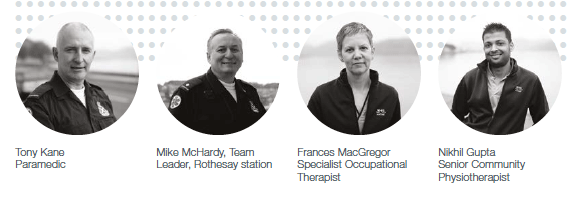
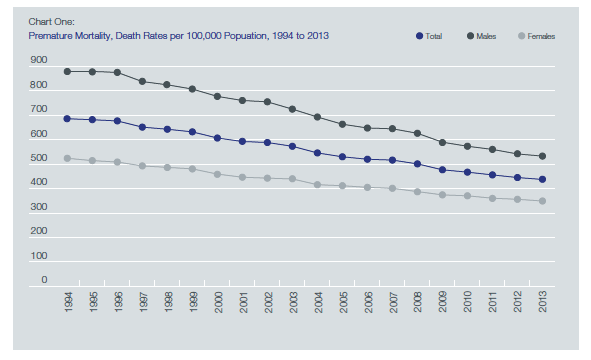
Source: National Records Scotland: Vital Events, Deaths: Age Standardised Death Rates
Through a relentless focus on quality improvement, NHSScotland is striving to secure the best possible outcomes for people through the care and support they receive and is working with partners to ensure that people receive the necessary service, at the right time, and in the most appropriate setting.
During 2013/14, NHSScotland continued to make progress in a number of key areas in the delivery of a high quality healthcare service for the people of Scotland. It continued to build on many of the advances in service delivery secured in previous years, maintaining or improving performance despite the ongoing challenges it faces.
This chapter highlights many of these successes, reflecting on what NHSScotland has delivered over both the short and longer term. It will set this in the context of the challenges faced by NHSScotland and its partners - such as tackling pressures in unscheduled care and behaviour-led health inequalities. Despite the challenges, NHSScotland is well positioned to deliver the aim of being recognised as world-leading in the delivery of healthcare services.
Through its work to improve people's health, NHSScotland has contributed significantly to the continued reduction in Scotland's mortality rate[4] - a trend which continued during the latest year. In 2013, the death rate was 1,152 deaths per 100,000 population, a decrease of 20 per cent since 2003. Reductions were greater still for certain conditions, with death rates due to diseases of the circulatory system, heart disease and stroke all down by over 40 per cent during the past 10 years.
Premature mortality (deaths amongst those aged under 75 years) has also reduced substantially, down 24 per cent since 2003 - including a 2 per cent reduction during the latest two years. Again, some causes of premature mortality have seen a sharper fall during this time, with early deaths due to heart disease down by almost half at 48 per cent and stroke deaths down by 43 per cent. Crucially, there has also been a significant reduction in early deaths due to heart disease and stroke in Scotland's most deprived communities, demonstrating one of the ways in which NHSScotland is supporting those areas with the poorest health outcomes[5].
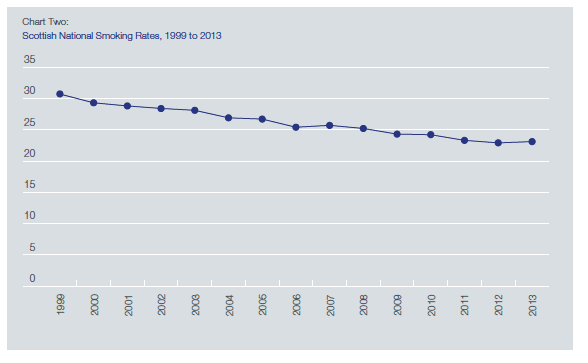
Source: Scottish Government: Scottish Household Survey, 2013 Annual Report
NHSScotland has supported improved population health in a number of ways. There have been recent improvements in the early detection of cancer, the biggest cause of early death in Scotland. The sooner that cancer is diagnosed and treated, the better the survival outcomes. In 2012/13, 24.3 per cent of lung, breast and colorectal cancers were diagnosed at the earliest stage, an increase of 4.7 per cent on the previous two years[6]. Early detection will become all the more important in the future as an ageing population will mean increases in cancer incidence.
NHS Boards continued to work with partners to prevent suicide, a major public health challenge. Significant progress has been made against a long-term target to reduce the national suicide rate by 20 per cent, with rates down 19 per cent from 17.4 per 100,000 population in 2000-2002 to 14.0 per 100,000 in 2011-13[7].
Work continued to improve the health and wellbeing of Scotland's population at all stages of the life-cycle. Antenatal support has increased, with 74.6 per cent of pregnant women in Scotland's most deprived areas booking for antenatal care by the twelfth week of gestation in 2012/13, up from 65.2 per cent one year earlier. This work builds on previous improvements in pregnancy outcomes, with smoking levels amongst expectant mothers falling from 24 per cent in 2004 to 18 per cent by 2013 - with an equivalent drop in deprived areas from 40 per cent to 30 per cent[8].
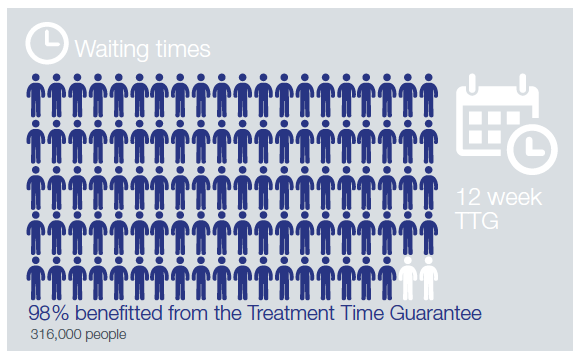
In early years, dental decay is the most common reason to admit a child to hospital. To help tackle this almost totally preventable condition NHSScotland has been delivering applications of fluoride varnish to 3 and 4 year olds, with a particular focus on those living in the most deprived areas. In 2014, 68 per cent of Primary 1 children had no obvious tooth decay, a slight increase from 67 per cent in 2012[9]. NHSScotland also delivered almost 17,000 Child Healthy Weight Interventions during the three years to 2013/14[10], with the aim of preventing the burden of disease that accompanies obesity in later life. In 2013, 69.6 per cent of children were a healthy weight, up slightly from 67.5 per cent in 2012[11].
Smoking remains the biggest cause of preventable ill health in adults and NHSScotland, through its smoking cessation services, made a significant impact over the three years to 2013/14. Over 70,000 users from the most deprived NHS Board areas quit for at least one month during this time[12] - with the programme contributing to a decrease in the national smoking rate from 25.4 per cent in 2006 to 23.1 per cent by 2013[13]. Over the same time, the proportion of 15-year-old school pupils who smoke regularly fell from 15 per cent to 9 per cent[14]. NHSScotland also delivered over 100,000 Alcohol Brief Interventions to help prevent the increased morbidity, mortality and social harm that results from excessive consumption[15]. The proportion of males drinking to hazardous or harmful levels fell from 33 per cent in 2003 to 22 per cent by 2013, with the female rate dropping from 23 per cent to 16 per cent[16]. Despite these improvements in levels of smoking and alcohol consumption, Scotland still lags behind many other countries and significant further progress will need to be made in the years ahead.
When NHS treatment is needed, shorter waiting times lead to earlier diagnosis and better outcomes, minimising unnecessary worry and uncertainty for patients. Over 2013/14 as a whole, NHSScotland continued to deliver the 18-week Referral-to-Treatment waiting time Standard[17], which applies to the whole 'pathway' from referral up to the point the patient is treated. During this time, 316,217 patients (98 per cent of the 322,550 treated) also benefited from the 12-week Treatment Time Guarantee for planned inpatient or day case procedures[18].
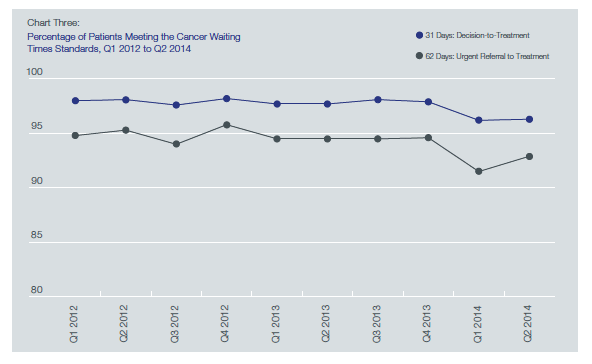
Source: ISD Scotland: NHS Waiting Times, Cancer Waiting Times
Over 2013/14, NHSScotland also continued to deliver shorter waits for specific procedures. The 31-day Decisionto- Treat to treatment cancer waiting time Standard was met and whilst some challenges remain for the 62-day urgent referral with suspicion of cancer to treatment waiting time measure, almost 93 per cent of patients met the Standard in April to June 2014[19]. Those needing treatment to help tackle drug and alcohol misuse benefited from another strong year of NHSScotland support, with almost 97 per cent beginning treatment within three weeks of referral during April to June 2014[20] and work continued to deliver the first waiting times target for those requiring IVF treatment, due by April to June 2015.
NHSScotland's waiting times performance also continues to compare favourably with the other three countries of the United Kingdom. A comparison of waits for 11 common procedures undertaken in 2012/13, including hip and knee replacements and cataract surgery, showed that patients in Scotland had the shortest average waits for nine of them[21]. As well as ensuring shorter waits, it is also vital that NHSScotland delivers the highest standard of quality and safety when providing treatment. Hospital Standardised Mortality Ratios, which compare observed deaths to predicted deaths, fell by 14.4 per cent between October-December 2007 and January-March 2014[22]. This demonstrated that, in the period leading up to early 2014, fewer patients died following treatment than would have been expected based on factors that are known to affect the underlying risk of death.
A further improvement made in patient safety is the significant reduction in levels of Healthcare Associated Infection (HAI). Rates of Clostridium difficile amongst those aged 65 and over fell by 8 per cent between 2012/13 and 2013/14, contributing to a 78 per cent decrease overall since 2007/08[23]. Rates of Methicillin-resistant Staphylococcus aureus (MRSA) fell by 16 per cent between 2012/13 and 2013/14, again contributing to an overall fall of 81 per cent since 2007/08[24].
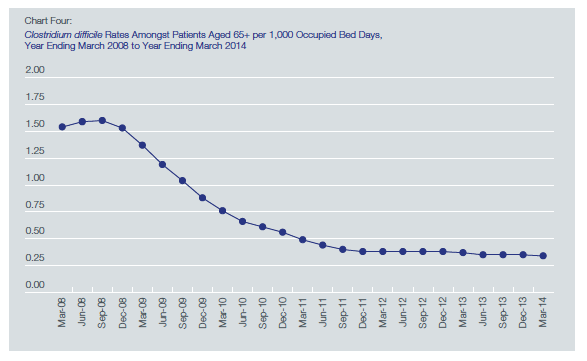
Source: Health Protection Scotland: Clostridium difficile Quarterly Report
Those treated by NHSScotland in 2014 also continued to report a positive experience, with 89 per cent of inpatients rating their care as good or excellent, the highest figure since the survey began in 2010[25]. Overall, patients reported a more positive experience than the previous survey in a number of areas of service delivery - including the hospital and ward environment, their care and treatment and interaction with staff. Other surveys of GP patient experience and maternity care also reported broadly positive outcomes - with 87 per cent of GP patients[26] and 93 per cent of pregnant women rating their care received during labour and birth as good or excellent[27].
Sometimes NHS treatment is needed on an emergency or unplanned basis and pressures in this area continue to be felt by some Accident and Emergency (A&E) departments. NHSScotland has worked hard to tackle this over the past year and has had some success in reducing the longest waits. In 2013/14, 651 patients waited in A&E departments for over 12 hours, a reduction of 56 per cent on the previous year[28]. Progress was also made in reducing the rate of A&E attendance with a 4.8 per cent decrease between 2009/10 and 2013/14. Challenges also remain with the flow of patients out of hospital and into the community, with the number of bed days lost to delayed discharge increasing by 8 per cent between 2012/13 and 2013/14 from 491,721 to 532,499[29]. However, delays of four weeks remain far lower than those experienced 10 years ago, dropping 85 per cent from 1,166 in April 2004 to 173 in April 2014.
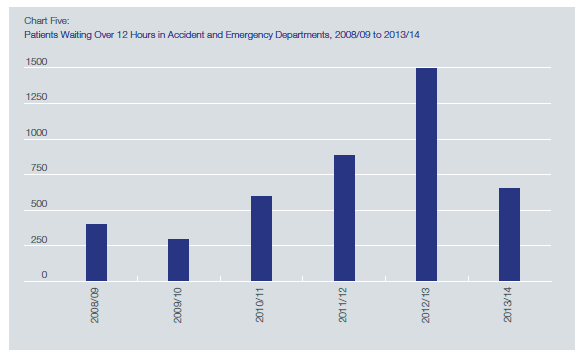
Source: ISD Scotland: Emergency Department Activity and Waiting Times
Improvements in the areas of unscheduled care and patient discharge will be a key outcome of the work undertaken by NHSScotland and its delivery partners in local government to integrate health and social care. Some progress is already being made - with more treatment being provided in an outpatient or daycase setting and with rates of emergency bed days for people aged 75 and over dropping significantly between 2009/10 and 2013/14[30], demonstrating that patients were spending less time in hospital before getting back into the community.
The achievements summarised in this chapter show that, while challenges remain, NHSScotland had another strong year of delivering high quality care in 2013/14. The following chapters will highlight how NHSScotland is achieving better health and care outcomes for the people of Scotland, with a focus on how it is improving quality of care, improving the health of the population, and securing value and financial sustainability.
Contact
There is a problem
Thanks for your feedback